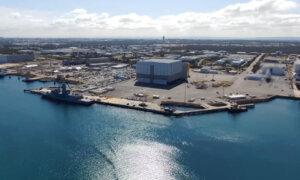AUKUS Too Large for Australia, Warns Think Tank
The Australia Institute has expressed deep concerns to a Senate Committee about the lack of planning for AUKUS.
A think tank has labeled the AUKUS Pillar One nuclear-propelled submarine project as “overly ambitious” and believes it could weaken Australia’s ability to address non-armed conflict security threats like pandemics.
In their submission to the Senate Committee reviewing the trilateral AUKUS treaty involving Australia, the United States, and the UK, the Australia Institute highlighted several issues with the agreement, noting a “lack of analysis and evidence supporting the AUKUS.”
The AUKUS arrangement, unveiled in September 2021, aimed to formalize existing defense collaborations among the three English-speaking allies and introduce new areas of cooperation such as quantum technology, hypersonics, and undersea drones.
The central focus of AUKUS is the decision to equip the Royal Australian Navy with nuclear-powered submarines, positioning Australia as the seventh country globally to operate such vessels, with the aim of countering Beijing’s maritime aggression in the Indo-Pacific.
‘Overly Ambitious’: Think Tank
The Australia Institute cautioned that the estimated cost of AUKUS, at $368 billion, lacked substantiation and could be three times higher based on previous experiences.
“AUKUS represents an overly ambitious strategy for a specific defense capability (submarines) that surpasses our defense requirements, distorts the national force structure, weakens our overall posture, and incurs opportunity costs affecting the longer-term well-being of the Australian community,” the organization’s submission stated.
The think tank described events and statements so far as “political theatre” lacking “domestic discussion on the factors necessitating a nuclear capability and a clear plan on how to achieve it without full reliance on allies.”

A nuclear propulsion Ohio class submarine, the USS Florida, sailed off the Bahamas coast on Jan. 22, 2003. As part of the AUKUS deal, Australia will get the technology for nuclear-powered subs. David Nagle/U.S. Navy/Getty Images
The submission also raised doubts about the ability of the three nations to produce the submarines, criticizing the AUKUS implementation approach as “inadequate” and suboptimal.
“There is little evidence supporting the confidence of ministers and officials that Australia has the technical capabilities for submarine construction and the necessary skilled workforce,” the Institute pointed out.
The submission noted the efficiency of previous submarine programs like the Collins program compared to the UK Astute program which has not yet completed after 40 years since its inception
The submission mentions that the Collins submarines, designed for Australia’s northern approaches, were well-suited for their purpose and emphasized the interoperability between the Australian and U.S. navies that allowed joint operational options not possible with nuclear submarines designed solely for hunting/attacking purposes.
The planned submarine design for Australia, the SSN-AUKUS, will replace the UK’s Astute-class submarines. However, before acquiring the new submarines, Australia is committed to purchasing U.S. Virginia-class submarines.

United States Navy and Royal Australian Navy sailors work together during the Submarine Tender Maintenance Period at Fleet Support Unit-West, HMAS Stirling in Western Australia. Photo: LSIS Rikki-Lea Phillips. Courtesy Australian Defence Force.
“Interoperability, a crucial operational goal for years, is now replaced by the broader term interchangeability, indicating the integration phase, which could see Australians comprising 10 percent of crew on U.S. Virginia-class submarines,” the Institute forecasts.
“This development has significant implications for Australia’s sovereignty and its ability to decide on national security preferences, including whether to support the U.S. in specific situations,” the submission noted.
Nuclear Waste Concern
The submission highlighted a lack of planning for storing and disposing of the nuclear materials used in the submarines’ engines.
“The complexity of military reactor operation and management unfamiliar to Australia will require significant demand on ADF and civilian technical skills for skills acquisition, certification, and technical proficiency. There is no indication yet of serious planning for the educational capacity needed for this task.”
The Institute mentioned the absence of standard methods for high-level military nuclear waste management, pointing out many decommissioned reactors rusting away, awaiting disposal in ports.
“While there is currently low volume of high-level radioactive waste, this will change significantly when Australia’s potential submarines reach the end of their operational life,” the Institute cautioned.
The submission urged the Committee to inform Parliament about concerns among active ADF personnel that the funding for AUKUS could diminish existing capabilities in other defense areas and recommended the government renegotiate the agreement to ensure adequate safeguards for maintaining national decision-making.
The submission coincides with the Congressional Research Service’s suggestion that AUKUS could be adjusted to have U.S. vessels operate from Australia instead of Australia acquiring U.S. Virginia-class submarines.
“An alternative approach to Pillar 1 as currently structured could involve a U.S.-Australia military division of labor where U.S. SSNs fulfill both U.S. and Australian missions while Australia invests in other military capabilities for non-SSN missions,” the report proposed.
“Rather than spending on its own SSNs, Australia could allocate resources to other military assets like long-range anti-ship missiles, drones, and long-range strike aircraft,” the report added.





